A Ripple in the Data Flow
Virtual Exhibition, Brooklyn New York, USAKuratiert von: Xinchen Du
Künstler*innen: Xingyang Cai, Gregory Edwards, Huang Guaier + Wang Runzhong, Xiang Geng, Tao Hui, Marc Lee, Molly Soda, Ziyang wu, Esther Xu, Payne Zhu, and more
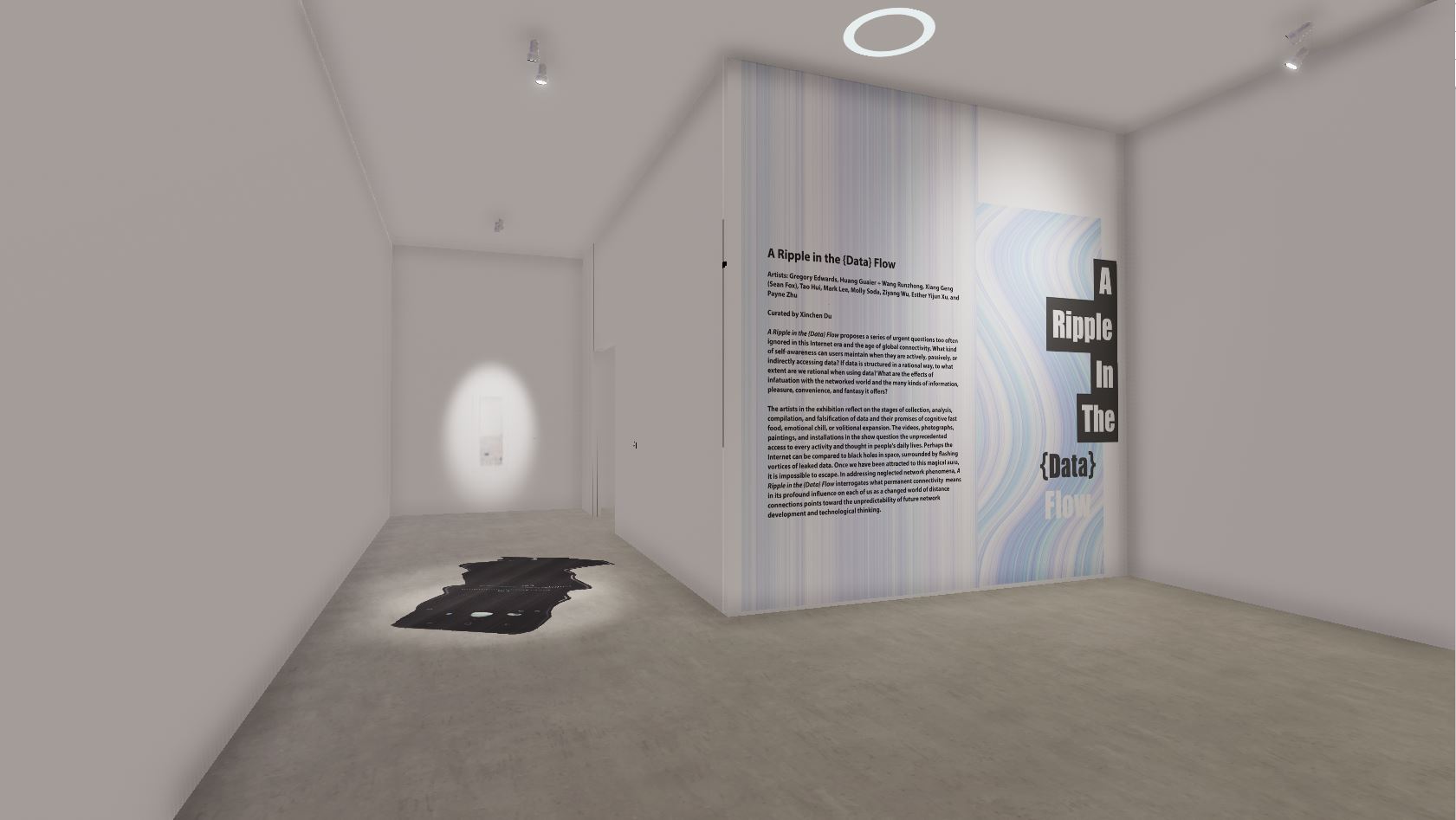
A Ripple in the Data Flow, online virtual exhibition, screenshot
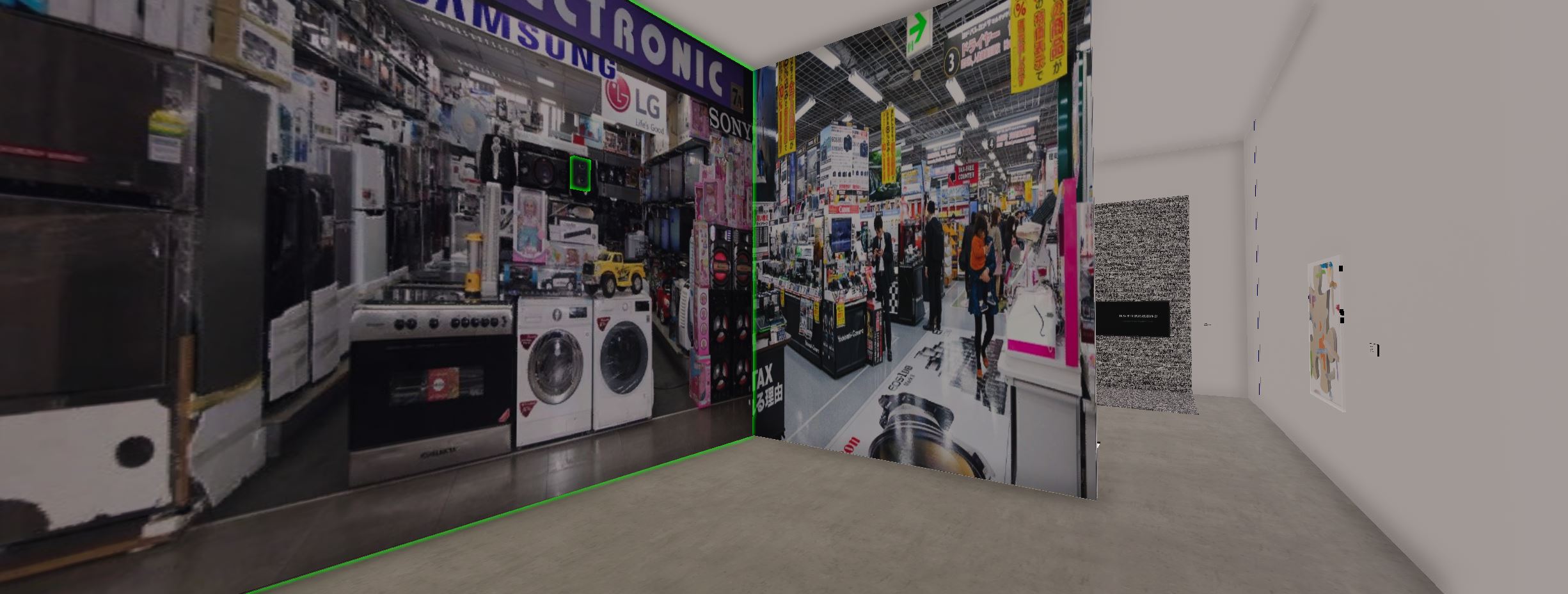
A Ripple in the Data Flow, online virtual exhibition, screenshot
This virtual exhibition was made possible with support from Steven Henry Madoff, Brian Kuan Wood, faculty at MA Curatorial Practice.
Special thanks to my mentors Natasha Ginwala and David Frankel for their guidance, the artists Gregory Edwards, Huang Guaier + Wang Runzhong, Xiang Geng (Sean Fox), Tao Hui, Marc Soda, Molly Soda, Ziyang Wu, Esther Yijun Xu, and Payne Zhu for their works and ideas, the MACP 2020 cohort, techinical support from ORTELIA team, and finally my family for their unwavering support.
Marc Lee’s installation SECURITY FIRST (2015) reflects on the fact that surveillance is becoming an entire industry. Here, the visitors come to a corner in which the perpendicular walls are covered by photos of random electrical appliances shops as if to created the real environment. A speaker is camouflaged in the picture will play an advertising announcement for convincing people to get a surveillance camera and secure their safety:
This is important: Make a clear choice to record and be recorded. Make a change. It’s your own individual right. We are the new generation. It’s a challenge, be virtually everywhere, create communities, network and exchange. Don’t escape and don’t occupy spaces, let them be open and free. And when you publish or talk to an algorithm, never be anonymous. Crime will fall rapidly. Our life will be better. Your choice is our choice.
Lee’s impassioned propaganda is ironic, but it accurately reflects the public’s dependence on, trust in, and anxiety about surveillance today. “Security” is a keyword in the work, with its double edge of safety and authoritarian oversight. What makes people feel like they're in a safe social environment? The meaning of security is very subjective and relative. Zoom in on the concept of surveillance, which has permeated every corner of social life, whether it's the setting up of CCTV or the supervision of the Internet, people are being watched in both the real and virtual world, or in other words being controlled. This extends to the idea of cybernetics. Cybernetics is a concept that has been introduced by Norbert Wiener (Cybernetics: Or Control and Communication in the Animal and the Machine, Cambridge: The MIT Press, February 1965) to denote the study of technological mechanisms. He regards cybernetics as a science that studies the general laws of control and communication in machines and living societies, and how dynamic systems maintain a state of equilibrium or stability under changing environmental conditions. Going back to Lee's work, CCTV as the subject of his research is actually one of the representations of cybernetics in the power system. There are two levels of control. First, CCTV in public space is the government's control over ordinary people. Volkswagen is being monitored. Over time, the public has gained the security of being seen, although this is now a paradox for surveillance, because our privacy and data have been made transparent through ill-used surveillance facilities. Second, as the public grows more comfortable with the security of surveillance, we will buy our own CCTV and install it around our properties. This is a way to gain a sense of security by observing your surroundings through the subject of composition control. That is to say, surveillance cameras have long been not just a simple tool, but containing right consciousness, and with the "panoptic effect" proposed by Foucault, has a strong binding force on people's body and mind. (Farnam Street, “Michel Foucault on the Panopticon Effect” https://fs.blog/2014/07/the-panopticon-effect/)
Internet users are a significant factor in making the Internet “material.” Through the various screens, carriers, and ports of the network, we enter cyberspace and interact with other individuals or groups. As users of the network, we experience and react to information on the Internet in different ways. What is the relationship between the individual and the netizen, the individual and the group, and between groups in the real world and groups in the virtual one?
When netizens interact online, the characteristics of their self-consciousness can be classified as invisibility, collectivization, and public opinion. First, simply put, the netizen is invisible online; the Internet is anonymous. In cyberspace people can create another identity, deliberately choosing whether to project their real personality onto a virtual user-name or to use that identity to disguise themselves. The network can hide users’ individual information, including physical data, emotions, and personality. Second, collectivization: the individual user is always looking for a group to relate to and to join. The essence of using social media is to get to know others, and you share your views, interests, and activities to find out who you can connect with. Finally, public opinion: in the era of rapid information flow made possible by the Internet, the influence of public opinion is huge. When people see news events and the public’s responses to them, responses that can now be openly and universally expressed rather than filtered through media such as television and newspapers, they often either completely oppose the positions and viewpoints put forward or unconsciously identify with what are actually subjective ideas. When the majority of people are in favor of a certain point of view, the impact is enormous.
After personalized algorithms became regularly used on the Internet, these new recommendations began to provide convenience for users to adopt and consume information. However, it has also put users in a self-imposed (filtered) “bubble,” which has negative effects such as information narrowing and content quality decline.
This virtual exhibition was made possible with support from Steven Henry Madoff, Brian Kuan Wood, faculty at MA Curatorial Practice.
Special thanks to my mentors Natasha Ginwala and David Frankel for their guidance, the artists Gregory Edwards, Huang Guaier + Wang Runzhong, Xiang Geng (Sean Fox), Tao Hui, Marc Soda, Molly Soda, Ziyang Wu, Esther Yijun Xu, and Payne Zhu for their works and ideas, the MACP 2020 cohort, techinical support from ORTELIA team, and finally my family for their unwavering support.
Text by Xinchen Du
Ausgestellt
10.000 Moving Cities - Same but Different, VR (Virtual Reality)
Interaktive Netz- und Telepräsenz-Basierte Installation10.000 Moving Cities - Same but Different beschäftigt sich mit Urbanisierung und Globalisierung im digitalen Zeitalter. Durch Umherlaufen und Kopfbewegungen bewegt sich der User durch Bildwelten, die andere öffentlich in sozialen Netzwerken wie YouTube, Flickr oder Twitter über den Ort gepostet haben. Diese persönlichen Eindrücke werden hier wie Fenster zur Welt in Echtzeit gestreamt. Der mehr …
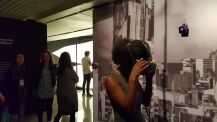
FILE, São Paulo
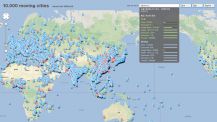
Interface
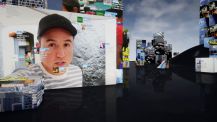
Screenshot
SECURITY FIRST
Mixed Media InstallationIn dieser Installation zeigt Marc Lee die wunderbare Welt der Überwachungstechnik. In einem Regal finden sich Kameras in allen möglichen Formen: klassisch, als möglichst echt aussehende Attrappen oder versteckt im Gehäuse eines Rauchmelders oder einer Wanduhr. Als Gegenentwurf zur Utopie der totalen Sicherheit durch Kameraüberwachung zeigt Lee die Webseite insecam.org: Die BesucherInnen der mehr …
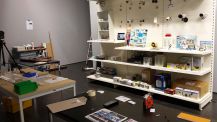
ZKM, Karlsruhe

Art Hall, Tallinn
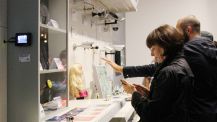
ZKM, Karlsruhe
Publikation
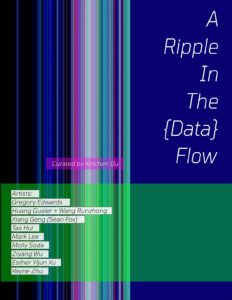
A Ripple In The {Data} Flow
MA Kuratiert vonial Practice, School of Visual Arts, NYKatalog
2020
English
by Xinchen Du
www.macp.sva.edu/a-ripple-in-the-data-flow, Cataloge (PDF)
A Ripple in the {Data} Flow proposes a series of urgent questions too often ignored in this age of global connectivity: What kind of self-awareness can users maintain when they are actively, passively, or indirectly accessing data? If data is structured in a rational way, to what extent are we rational when using data? What are the perils of infatuation with the networked world and the many kinds of information, pleasure, convenience, and fantasy it offers? Curated amid the unprecedented human novel coronavirus (COVID-19) pandemic,
mehr …